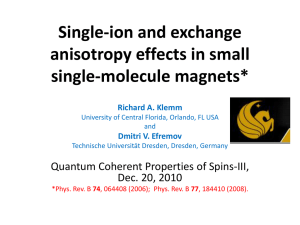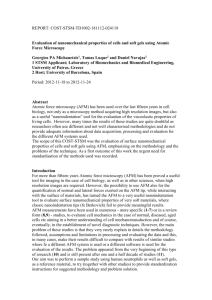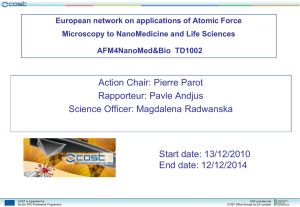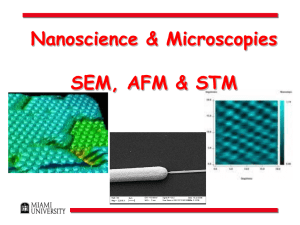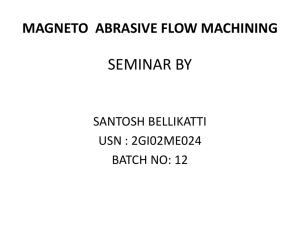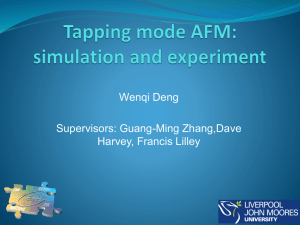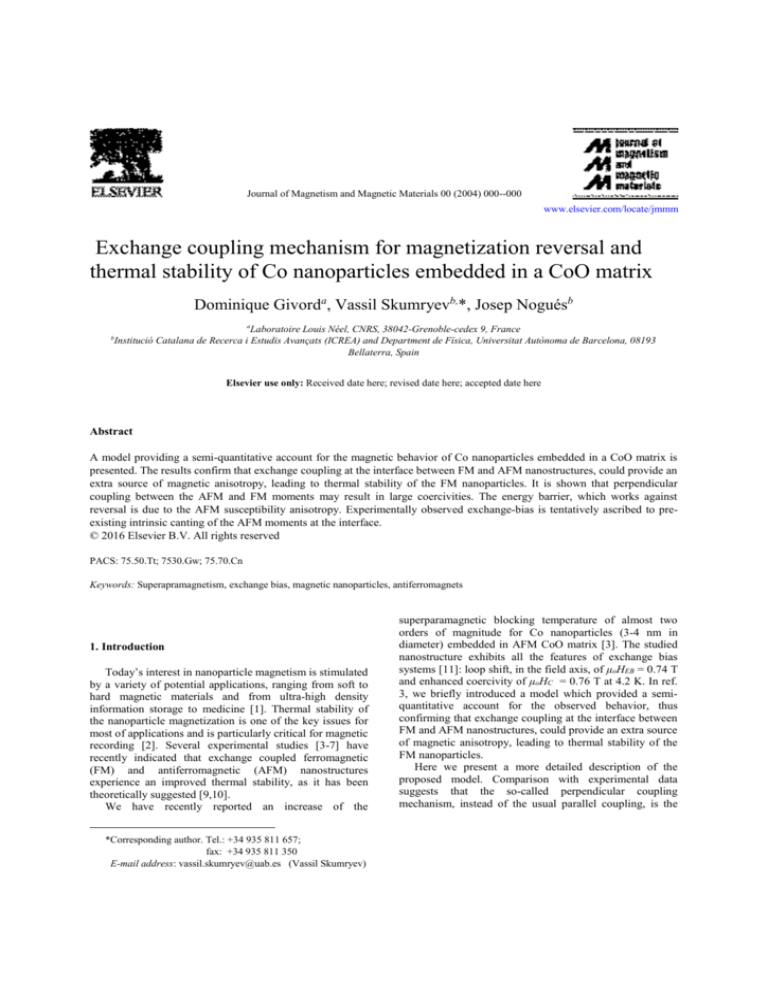
Journal of Magnetism and Magnetic Materials 00 (2004) 000--000
www.elsevier.com/locate/jmmm
Exchange coupling mechanism for magnetization reversal and
thermal stability of Co nanoparticles embedded in a CoO matrix
Dominique Givorda, Vassil Skumryevb,*, Josep Noguésb
a
Laboratoire Louis Néel, CNRS, 38042-Grenoble-cedex 9, France
Institució Catalana de Recerca i Estudis Avançats (ICREA) and Department de Física, Universitat Autònoma de Barcelona, 08193
Bellaterra, Spain
b
Elsevier use only: Received date here; revised date here; accepted date here
Abstract
A model providing a semi-quantitative account for the magnetic behavior of Co nanoparticles embedded in a CoO matrix is
presented. The results confirm that exchange coupling at the interface between FM and AFM nanostructures, could provide an
extra source of magnetic anisotropy, leading to thermal stability of the FM nanoparticles. It is shown that perpendicular
coupling between the AFM and FM moments may result in large coercivities. The energy barrier, which works against
reversal is due to the AFM susceptibility anisotropy. Experimentally observed exchange-bias is tentatively ascribed to preexisting intrinsic canting of the AFM moments at the interface.
© 2016 Elsevier B.V. All rights reserved
PACS: 75.50.Tt; 7530.Gw; 75.70.Cn
Keywords: Superapramagnetism, exchange bias, magnetic nanoparticles, antiferromagnets
1. Introduction
Today’s interest in nanoparticle magnetism is stimulated
by a variety of potential applications, ranging from soft to
hard magnetic materials and from ultra-high density
information storage to medicine [1]. Thermal stability of
the nanoparticle magnetization is one of the key issues for
most of applications and is particularly critical for magnetic
recording [2]. Several experimental studies [3-7] have
recently indicated that exchange coupled ferromagnetic
(FM) and antiferromagnetic (AFM) nanostructures
experience an improved thermal stability, as it has been
theoretically suggested [9,10].
We have recently reported an increase of the
*Corresponding author. Tel.: +34 935 811 657;
fax: +34 935 811 350
E-mail address: vassil.skumryev@uab.es (Vassil Skumryev)
superparamagnetic blocking temperature of almost two
orders of magnitude for Co nanoparticles (3-4 nm in
diameter) embedded in AFM CoO matrix [3]. The studied
nanostructure exhibits all the features of exchange bias
systems [11]: loop shift, in the field axis, of μoHEB = 0.74 T
and enhanced coercivity of μoHC = 0.76 T at 4.2 K. In ref.
3, we briefly introduced a model which provided a semiquantitative account for the observed behavior, thus
confirming that exchange coupling at the interface between
FM and AFM nanostructures, could provide an extra source
of magnetic anisotropy, leading to thermal stability of the
FM nanoparticles.
Here we present a more detailed description of the
proposed model. Comparison with experimental data
suggests that the so-called perpendicular coupling
mechanism, instead of the usual parallel coupling, is the
2
Author name / Journal of Magnetism and Magnetic Materials 00 (2016) 000–0001
dominant mechanism involved in this type of
nanostructures. The proposed model can be used when
discussing exchange coupled FM/AFM nanostructures,
similar to the one described here.
2. The Model
2.1 Basic parameters
Based on Meiklejohon and Bean rigid spin model, the
classical expression of the bias field, HEB, can be written as
[12]:
H EB J ex S FM S AFM / AM FM t FM
(1)
where SFM and SAFM are the individual FM and AFM spins,
MFM is the ferromagnetic magnetization, tFM is the
ferromagnetic layer thickness, and A is the surface area
over which the exchange term is calculated. In CoO, the
total Co moment is 3.8 µB and the orbital-to-spin ratio, L/S
= 0.95, from which the AFM spin moment µAFM= 2.55 µB
is derived. The parameter JexSFMSAFM, may be re-expressed
as µ0 µAFM Hexch, where Hexch is an effective exchange field
created by the ferromagnetic spin moments. For Co/CoO,
from the accepted value of Jex SFM SAFM = 143 K [13],
µ0Hexch = 84 T can be derived (see App. A).
2.2 Parallel versus perpendicular coupling
A priori, two possible coupling mechanisms may be
envisaged between the FM and the AFM moments at the
interface.
(i) Usually, the FM moments are assumed coupled
parallel to the uncompensated AFM moments. In principle,
uncompensated moments (in otherwise compensated AFM
structure) could arise only on a flat surface, which is
perpendicular to the propagation vector of the
antiferromagnetic structure. In the present case, the FM Co
nanoparticles can be viewed as embedded inside small
cavities of an AFM CoO single crystal (see Fig.1). There is
no reason for the AFM side of the interface to show strong
uncompensation, except the one due to statistics.
Considering that the surface per Co atom in the CoO
structure is 0.072 nm [14]. and assuming that the CoO shell
at the surface of the metal core has an average diameter of
4.2 nm it is deduced that there are approximately 750 Co
atoms at the AFM interfaces and the unbalance should be
of the order of 750 = 27 atoms ≈ 4 % of the total number
of atoms. The interface coupling energy between the AFM
and FM magnetization may thus be expressed as - 0.04
µ0HexchM’ where M’ is the AFM magnetization, which is
derived from µAFM and amounts to 0.76 T. The interface
coupling energy, normalized to the volume, VAFM (VAFM =
10-26 m3), of one CoO atomic layer at the interface with the
Co core, it amounts to approximately – 0.2 107 J/m3.
(ii) Another mechanism may also be envisaged, which
does not require un-compensation to be invoked. At a
compensated interface (Fig.1a), the number of AFM
moments from each sublattice is the same, the resulting
magnetisation is zero and thus the coupling vanishes to first
order. To second order, the FM moments couple
perpendicular to the AFM moments (Figures 1b and 2a),
the exchange field induces a canting of the AFM moments
along the direction denoted z and a ferromagnetic
component is induced along the FM Co moments [15-16].
Considering that Hexch is formally equivalent to an external
field, the coupling energy can be written as [18] :
2
E (1 / 2) AF 0 H exch
(2)
where AF is the interface AFM susceptibility. This
expression is fully analogous to the classical expression
describing the behaviour of an antiferromagnet in an
applied magnetic field. The minimum energy state is given
by the configuration between the FM and AFM moments,
such that the AFM susceptibility is a maximum. In the case
of CoO, it may be assumed that there exists an easy
magnetization plane, PAFM, approximately perpendicular to
the [111] difficult direction. The AFM moments are
confined in this plane and the corresponding susceptibility
may be called max (the superscript max indicates that the
susceptibility is maximum within P AFM). This max could
be expressed [17] as
max 1 / w(1 ) with K1 / 2w 0 M ' 2
where w is the molecular field coefficient between AFM
sublattices, and K1 is the second order anisotropy constant,
relative to the anisotropy difference between the AFM axis
and the direction along which Hexch is induced.
The parameter values used in the calculation were w =
100 (see App. B) for the surface intersublattice molecular
field coefficient and K1 = 2.7 107 J/m3 (in the absence of
experimental data for the CoO anisotropy constant, we took
the theoretical value derived by Kanamori [19]). One
obtains 2wµ0M’2 = 0.9 10 7 J/m3, thus = 0.3 and E = 2.1 107 J/m3. The canting angle is thus estimated to about
24°. The coupling energy, in the perpendicular coupling
case, is one order of magnitude larger than the one due to
un-compensation, calculated above in the case of parallel
coupling.
2.3. Magnetization Reversal and Coercivity
Qualitatively, the experimentally observed large values
of coercive field HC (and bias field HEB) may be ascribed to
the fact that interface effects (i.e., HEB 1/tFM in thin films)
are relatively larger for such extremely small nanoparticles
than they are for multilayers whose typical thickness is
around 20 nm. Additionally, the coercive field of small
nanoparticles, which reverse their magnetisation by
coherent rotation, is in general bigger than that of large
systems where reversal is nucleated at defects.
Author name / Journal of Magnetism and Magnetic Materials 00 (2016) 000–0001
Quantitatively, the existence of a large coercivity in the
present system may be ascribed to the fact that the
antiferromagnetic susceptibility, AF, in Eq. 2 is expected to
show anisotropy and thus an energy barrier against reversal
should exist.
To evaluate the strength of the coercive field, let us
assume that a field is applied antiparallel to the initial
magnetisation direction. FM magnetisation reversal may
occur within PAFM or within the plane P, which is
perpendicular to the axis x of easy AFM magnetisation and
contains the difficult directions (Figures 2b and 2c,
respectively).
The energy barrier per unit volume, E, may be
expressed as :
2
E (1 / 2) 0 H exch
(4)
where is the susceptibilty anisotropy, i.e. the difference
between the initial direction of maximum susceptibility and
the direction of minimum susceptibility within the rotation
plane.
In the case when the rotation occurs within P AFM, (Fig.
2b), the susceptibility is a minimum when the FM moments
are aligned along x At 0K, vanishes along x, thus
max = -7.6 10-3 and E = 2.1 107 J/m3 is obtained.
On the other hand when the rotation occurs within P,
(Fig. 2c), w 1 (1 ) 1 and E = 6.4
106 J/m3 are derived. The energy barrier is 3 times smaller
for this process than for rotation within P AFM and it is
concluded that rotation occurs within P(, since the energy is
lower.)
Taking into account that that HA=2K/µ0Ms=2 E/µ0Ms
and Hc = 0.5HA, due to the random orientation of easy axis,
the deduced coercive field is µ0Hc = emin/MsVFM where
emin=EminVAFM (Emin is the minimum energy barrier per
unit volume), VFM is the FM nanoparticle volume (33.5
nm3) and Ms is the ferromagnetic spontaneous
magnetization (µ0Ms = 1.8 T). Using these values µ0Hc =
1.3 T is obtained. Considering the uncertainty in the values
of most of these parameters, the agreement with the
experimental value, µ0Hc = 0.76 T, can be considered as
very satisfactory.
It is worth mentioning that unlike usual thin film
exchange-bias systems, calculated and experimental
coercive field values are in fair agreement. Due to their
very small size, the FM particles can be thought to be
coupled to a unique AF domain and consequently there is
no competition between different coupling terms.
As discussed in Ref. 3, this energy barrier also gives rise
to an improvement of the thermal stability of the
nanoparticles, which results in an enhancement of the
superparamagnetic blocking temperature.
2.4 Exchange Bias
Exchange bias implies that the FM/AFM coupling
3
energy differs in the initial and the final magnetization
states of the Co FM nanoparticles. In the present model, the
energies of these two states are equal (see Figures 2a and
2d). Thus, the model cannot account for the existence of
exchange bias in the Co/CoO system.
Exchange bias is usually ascribed to uncompensation
of the AFM magnetization [13, 16, 17] and we thus
considered the possible contribution of such a term. As
mentioned above, on the basis of statistical considerations,
the uncompensated AFM magnetization is expected to be
about 4%. To first order, the FM moments align at an angle
from z, such that tg = (0.04 cotan24°)/2, thus = 2.6°.
It may be assumed that after cooling under field, the FM
moments are aligned at an angle from z and that they
reverse by 180° under field. This provides an approximate
value for the bias-field, HEB, according to this process
which is given by :
0 M s H EBVFM 0.04 sin cos 24 0 0 M ' H exchV AFM
(5)
The calculated bias field is two orders of magnitude
smaller than the experimental one, i.e. this mechanism
cannot be the source of the experimentally observed
exchange bias.
An alternative mechanism for exchange bias may be
suggested that requires that the AFM moments show an
intrinsic canting i.e. different from the one induced by
µ0Hexch. Such a canting is known to exist at the surface of
magnetic oxide nanoparticles [19, 20], where it leads to the
appearance of a ferromagnetic moment which is 5-10 times
higher than the one expected from uncompensation. By
analogy it may be expected to exist at the surface of small
cavities.
Let ’ be a phenomenological angle representative of
the intrinsic canting. The bias field is given by :
0 M s H EBVFM J ex S FM S AFM 2 sin '
From µ0HEB = 0.74 T, and the same values as above for
other parameters, one obtains sin' = 0.41 and ' = 24°.
This is of the same order of magnitude as in magnetic oxide
nanoparticles [21].
Note that as a result of this intrinsic canting, the
coercive energy barrier discussed in section 2.2, is reduced
by a factor of approximately cos ' (≈ 0.9). Consequently,
the disagreement between the calculated and experimental
coercive field is further reduced.
3. Conclusions
For Co nanoparticlees embedded in an AFM matrix, we
have shown that perpendicular coupling between the AFM
and FM moments may be the source of large coercivities.
The energy barrier which works against reversal is due to
the AFM susceptibility anisotropy. This energy barrier also
4
Author name / Journal of Magnetism and Magnetic Materials 00 (2016) 000–0001
results in an improvement of the thermal stability of the
nanoparticles. Conversely, exchange-bias is tentatively
ascribed to pre-existing canting of the AFM moments at the
interface.
Appendix A. Exchange field evaluation
In the classical expression for the bias field, eq.1, the
left-hand side term represents the Zeeman energy over the
volume At FM , while the right-hand side term represents the
interfacial exchange energy, over the surface area A, i.e.,
the exchange energy per unit area is :
Eexc J ex SFM S AFM / A
(A1)
To relate expressions (1) and (A1) to usual expressions for
exchange energy, let the exchange energy between 2 spins
SFM and SAFM be expressed as :
eFM-AFM= 2JSFMSAFM
(A2)
where J is the exchange integral. Considering that a given
AFM spin has zAFM-FM FM neibghours, and the exchange
energy per AFM spin is :
eAFM= 2 zAFM-FM JSFMSAFM.
(A4)
where AAFM is the surface area occupied by one Co AFM
atom.
In the detailed calculation [13], the interfacial exchange
energy Ui over the crystallite i is obtained by summing over
the N AFM interfacial atoms. This implies that the
calculations were performed by using the AFM atoms as
reference, as done in the present discussion. Thus,
equations (5) and (2) lead to :
(2 / AAFM ) z AFM FM J J ex / AAFM
(A5)
Thus Jex in (2) is related to the usual exchange integral J
through :
Jex = 2 zAFM-FMJ
(A6)
The exchange field on a given AFM moment is obtained
from :
Jex SFMSAFM = µAFMµ0Hexch
Within the molecular field formalism, two molecular
field coefficients may be defined, w and w’, which
represent the coupling energy within a given sublattice and
between sublattices respectively. w and w’ are related to TN
2
through w w' 3kTN / N ' 0 eff
, where N’ is the number of
atoms per unit volume within a given sublattice and µeff is
the antiferromagnetic Co effective moment. The Néel
temperature and lattice parameter for CoO areTN = 293 K
and a = 0.426 nm, respectively. In CoO, the spin and orbital
moments are known from X-ray magnetic diffraction. From
the Co spin moment in CoO, µs = 2.55 µB, one derives a
spin effective moment µeff = 3.40 µB. Thus w+w’= 320.
Surface atoms have 9 neighbours instead of 12, assuming
that the molecular field coefficients are reduced in
,
proportion, one obtains: wsurf wsurf
= 240. We arbitrarily
assumed w = w’. Thus wsurf = wsurf’ = 120. Assuming that
only surface atoms are canted under the effect of Hexch and
with w = w’, the exchange energy arising from the coupling
with the FM moments is 5/3 wM ' 2 instead of 2 wM 2 for
a usual antiferromagnet ( is the canting angle induced by
the FM exchange field on the interface Co atoms of the
CoO AFM matrix). Thus, the coefficient to be taken in the
usual expression of the susceptibility is 120 x 5/6 = 100.
(A3)
from which one derives the energy per unit surface area :
Eexch (2 / AAFM ) z AFM FM JS FM S AFM
Appendix B. Molecular field coefficients evaluation
(A9)
From JexSCoSCoO = 143 K [13] and from µAFM = 2.55µB (spin
part of the moment only, see appendix B). µ0Hexch = 84 T is
derived.
Appendix C. Coherent rotation
At small particle sizes, coherent rotation is favoured
since the domain wall energy, a surface energy term,
becomes larger than the Zeeman energy, a volume energy
term. Recent experimental measurements on Co
nanoparticles have experimentally demonstrated the
occurrence of coherent rotation [22]. In the present case,
the situation is different since the Co nanoparticles are
coupled to the antiferromagnetic matrix and we may
assume that a domain wall forms within the matrix during
reversal. The domain wall energy within the AFM matrix is
estimated to be wall 5 10-2 J/m2 (A = 5.5 10-12 J/m and K1
= 2.7 107 J/m3 are assumed). Assuming that the wall surface
area equals the nanoparticle surface area, one obtains Ewall
= 3.7 10-18 J. This energy is much larger than the
experimental exchange bias energy which is given by the
Zeeman energy, 2 10-19 J, or than the calculated energy
barrier for coherent rotation which is 3.4 10-19 J. Hence, it
can be concluded that reversal necessarily occurs by
coherent rotation.
Aknowledgments
Financial support from the NEXBIAS (HPRN-CT 200200296), the 2001-SGR-00189 and the MAT-2004-01679
research projects is acknowledged.
Author name / Journal of Magnetism and Magnetic Materials 00 (2016) 000–0001
References
[1] R.H. Kodama, J. Magn. Magn. Mater. 200 (1999) 359.
[2] D. Weller, A. Moser, IEEE Trans. Magn. 35 (1999) 4423.
[3] V. Skumryev, S. Stoyanov, Y. Zhang, G. Hadjipanayis, D.
Givord, J. Nogués, Nature 423 (2003) 850.
[4] K. Liu, J. Nogués, C. Leighton, H. Masuda, K. Nishio, I. V.
Roshchin, I. K. Schuller Appl. Phys. Lett. 81, (2002) 4434.
[5] C. Frandsen, C. W. Ostenfeld, M. Xu, C. S. Jacobsen, L.
Keller, K. Lefmann, S. Morup, Phys.Rev. B 70 (2004)
134416
[6] S. Stoyanov, V. Skumryev, Y. Zhang, Y. Huang, G.
Hadjipanayis, J. Nogués, J. Appl. Phys. 93 (2003) 7592.
[7] J. Eisenmenger, I. K. Schuller, Nature Materials 2 (2003)
437.
[8] J. Nogués, J. Sort V. Langlais, S. Doppiu, B. Dieny, J.S.
Muñoz, S. Suriñach, M.D. Baró, S. Stoyanov, Y. Zhang, Int.
J. Nanotechnology (2005) in press.
[9] P. J. Jensen, Appl. Phys. Lett. 78 (2001) 2190.
[10] J. Mejía-López, D. Altbir, and I.K. Schuller,Appl. Phys. Lett.
83, 332 (2003).
[11] J. Nogués, I. K. Schuller, J. Magn. Magn. Mater. 192 (1999)
203.
[12] W. H. Meiklejohn, C. P. Bean, Phys. Rev. 105 (1957) 904
[13] K. Takano, R. H. Kodama, A. E. Berkowitz, W Cao, G.
Thomas, Phys. Rev. Lett. 79 (1997) 1130
[14]Landolt-Börnstein, Numerical data and functional relationships
in Science and Technology (Springer-Verlag, Berlin, 1975) 7,
II.1.1
[15] N. C. Koon, Phys. Rev. Lett. (1997), 78(25), 4865
[16] T. C. Schulthess, W. H. Butler, Phys. Rev. Lett. 81, (1998)
4516.
[17] R. L. Stamps, J. Phys. D: Appl. Phys. 33 (2000) R247.
[18] S. Chikazumi, Physics of Ferromagnetism, (Oxford University
Press, New York, 1997).
[19] J. Kanamori, Prog. Theor. Phys. 17 (1957) 177.
[20] R. H. Kodama, S. H. Makhlouf, A. E. Berkowitz, Phys. Rev.
Lett. 79 (1997) 1393.
[21] J. M. D. Coey, Phys. Rev. Lett. 27 (1971) 1140.
[22] M. Jamet, W. Wernsdorfer, C. Thirion, D. Mailly, V. Dupuis,
P. Melinon, A. Perez, Phys. Rev. Lett., 86 (2001) 4588.
Figure captions
Fig.1. Possible coupling schemes for magnetic moments of
Co nanoparticles embedded in CoO: (a) uncompensated
case – parallel coupling; (b) compensated case –
perpendicular coupling.
Fig.2. Possible schemes for magnetization reversal: (a)
initial state; (b) magnetization rotation within the AFM
easy plane; (c) magnetization rotation in the plane
perpendicular to the AFM easy axis; (d) final state.
5


